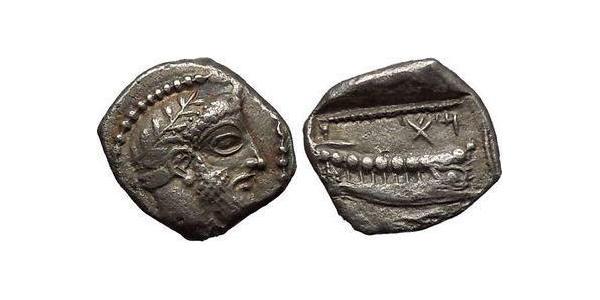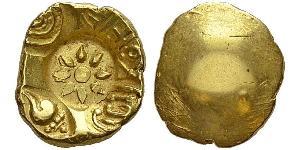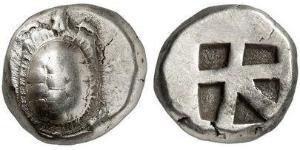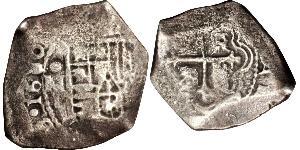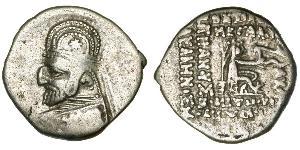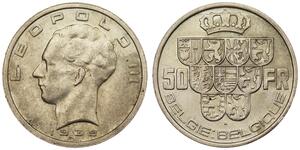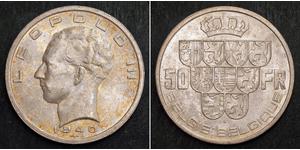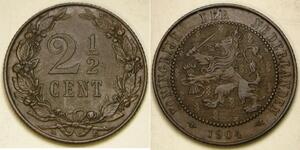[ 5773] PHOENICIA: Arados Silver Third Stater (17mm ,3.34 gm.) c.380-350 B.C. References: BMC 27ff; Betlyon 11. Head of bearded diety facing right, laureate. War galley travelling right, waves below, Phoenician letters above. Provided with certificate of authenticity. CERTIFIED AUTHENTIC by Sergey Nechayev, PhD - Numismatic Expert An important city of northern Phoenicia, Arados itself occupied an island but it controlled an extensive area on the mainland. Arwad (Arabic: أرواد) – formerly known as Arado (Greek: Άραδο), Arados (Greek: Άραδος), Arvad, Arpad, Arphad, and Antiochia in Pieria (Greek: Αντιόχεια της Πιερίας), also called Ruad Island – located in the Mediterranean Sea, is the only inhabited island in Syria. The town of Arwad takes up the entire island. It is located 3 km from Tartus, Syria's largest port. Today, it is mainly a fishing town. (Arados was also a Greek name for Muharraq near Bahrain.) Ancient history The island was settled in the early 2nd millennium BC by the Phoenicians. Under Phoenician control, it became an independent kingdom called Arvad or Jazirat (the latter term meaning "island"). The Phoenician name for the city was probably (Aynook). In Greek it was known as Arados. The city also appears in ancient sources as Arpad and Arphad. The city was renamed Antiochia in Pieria by Antiochus I Soter. The island was important as a base for commercial ventures into the Orontes valley. Arvad was an island city off the coast of Syria some 30 miles north of Tripolis. It was a barren rock covered with fortifications and houses several stories in height. The island was about 800 feet long by 500 feet wide, surrounded by a massive wall, and an artificial harbor was constructed on the east toward the mainland. It developed into a trading city in early times, as did most of the Phoenician cities on this coast. It had a powerful navy, and its ships are mentioned in the monuments of Egypt and Assyria. It seems to have had a sort of hegemony over the northern Phoenician cities, from the mouth of the Orontes to the northern limits of Lebanon, something like that of Sidon in the south. It had its own local dynasty and coinage, and some of the names of its kings have been recovered. Its inhabitants are mentioned in the early lists of Genesis (10:18), and Ezekiel (27:8,11) refers to its seamen and soldiers in the service of Tyre. It brought under its authority some of the neighboring cities on the mainland, such as Marathos and Simyra, the former nearly opposite the island and the latter some miles to the south. Thutmose III, of Egypt, took it in his campaign in north Syria (1472 BC) and it is noticed in the campaigns of Ramesses II in the early part of the 13th century BC (Breasted, Ancient Records). It is also mentioned in the Tell el-Amarna Letters as being in league with the Amorites in their attacks on the Egyptian possessions in Syria (44 and 28, B.M. Tell el-Amarna Letters). About the year 1200 or later, it was sacked by invaders from Asia Minor or the islands, as were most of the cities on the coast (Paton, Syria and Palestine, 145) but it recovered when they were driven back. Its maritime importance is indicated by the inscriptions of the Assyrian kings. Tiglath-pileser I (circa 1020) boasts that he sailed in the ships of Arvad. Ashurnasirpal II (circa 876) made it tributary, but it revolted, and we find 200 men of Arvad mentioned among the allies of Hadadezer of Aram Damascus at the Battle of Qarqar, when all Syria seems to have been in league against Shalmaneser II (circa 854). At this time the king of Arvad was Mattan Baal. It was afterward tributary to Tiglath-pileser III and Sennacherib, the king who paid it to the latter being Abd-ilihit (circa 701). Ashurbanipal (circa 664) compelled its king Yakinlu to submit and send one of his daughters to become a member of the royal harem (Rawlinson, Phoenicia, 456-57). Under the Persians Arvad was allowed to unite in a confederation with ...
type to read more

|
Posted by:
anonymous 2015-08-18 |
Similar Coin Groups
2025-05-24
- New coin is added to 50 Franc Belgium Silver
50 Franc Belgium Silver
group has 3 coins / 3 prices
⇑
1940, Kingdom of Belgium, Leopold III. Beautiful Silver 50 Francs Coin. AU-UNC! Mint Year: 1940 Mint Place: Brussels References: KM-121. Denomination: 50 Francs Condition: Lustre AU-UNC! M ...
2025-06-18
- Live Coin Catalog's improvements / coins grouping
22 coins were grouped from 2025-06-11 to 2025-06-18
One of them is:
2 1/2 Cent Netherlands
group has 18 coins / 14 prices
⇑
NETHERLANDS 2-1/2 Cents 1904 - Copper - Wilhelmina - XF/aUNC - 3791 *
You may be interested in ...

